Automotive Plastics Market Size 2025-2029
The automotive plastics market size is valued to increase USD 15 billion, at a CAGR of 3.5% from 2024 to 2029. Increasing demand for electric and hybrid vehicles will drive the automotive plastics market.
Major Market Trends & Insights
- APAC dominated the market and accounted for a 53% growth during the forecast period.
- By Material - Polypropylene segment was valued at USD 23.70 billion in 2023
- By Vehicle Type - Passenger vehicle segment accounted for the largest market revenue share in 2023
Market Size & Forecast
- Market Opportunities: USD 33.10 billion
- Market Future Opportunities: USD 15.00 billion
- CAGR from 2024 to 2029 : 3.5%
Market Summary
- The market is experiencing significant growth, with global revenues projected to reach USD 115.2 billion by 2026. This expansion is driven by the increasing demand for lightweight and fuel-efficient materials in the automotive industry. Complex design and engineering requirements further fuel market growth, as plastics offer versatility and durability in vehicle manufacturing. Automotive plastics provide numerous benefits, including reduced vehicle weight, improved fuel efficiency, and enhanced safety features. Their use in various applications, such as body panels, interior components, and under-the-hood components, contributes to the overall functionality and future direction of the automotive industry. Despite these advantages, challenges persist.
- Regulatory compliance and sustainability concerns are key challenges for market participants. However, advancements in recycling technologies and the development of bio-based plastics offer potential solutions. In summary, the market is poised for continued growth, driven by the need for lightweight and fuel-efficient materials in the evolving automotive landscape. Market participants must navigate regulatory requirements and sustainability concerns while capitalizing on advancements in recycling technologies and bio-based plastics to remain competitive.
What will be the Size of the Automotive Plastics Market during the forecast period?
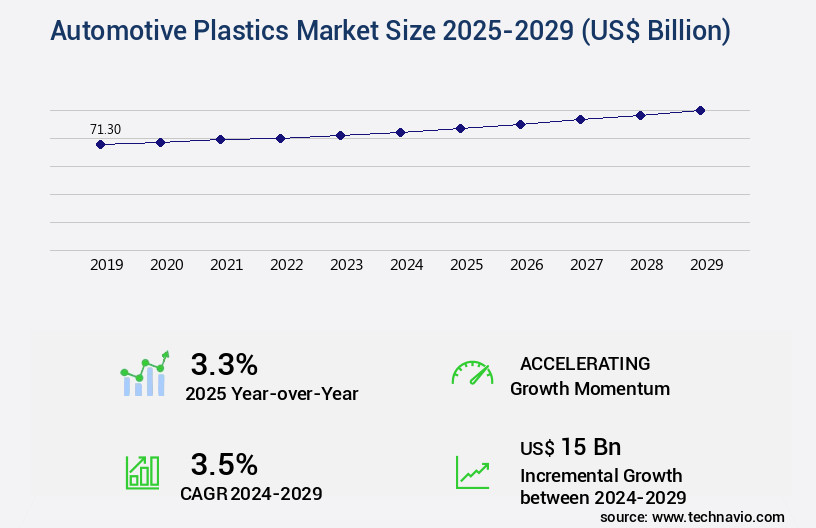
Get Key Insights on Market Forecast (PDF) Request Free Sample
How is the Automotive Plastics Market Segmented ?
The automotive plastics industry research report provides comprehensive data (region-wise segment analysis), with forecasts and estimates in "USD billion" for the period 2025-2029, as well as historical data from 2019-2023 for the following segments.
- Material
- Polypropylene
- Polyurethane
- Polyvinyl chloride
- Others
- Vehicle Type
- Passenger vehicle
- Commercial vehicle
- Electric vehicle
- Application
- Interior components
- Exterior components
- Under bonnet
- Electrical components
- Others
- Geography
- North America
- Europe
- APAC
- Australia
- China
- India
- Japan
- South Korea
- Rest of World (ROW)
By Material Insights
The polypropylene segment is estimated to witness significant growth during the forecast period.
The market continues to evolve, with polypropylene (PP) remaining a preferred choice for automakers due to its cost-effectiveness and desirable properties. Lightweight PP contributes significantly to reducing vehicle weight, enhancing fuel efficiency, and decreasing emissions. Widely utilized in interior components like instrument panels, door panels, consoles, and trims, PP offers excellent dimensional stability and resistance to wear and tear. Injection molding and blow molding processes are commonly used to create these parts, ensuring high surface finish quality and dimensional accuracy control. Exterior plastic components, such as bumpers and fenders, also benefit from PP's chemical resistance and impact strength. Polypropylene is also employed in automotive HVAC systems, air ducts, and other air management components.
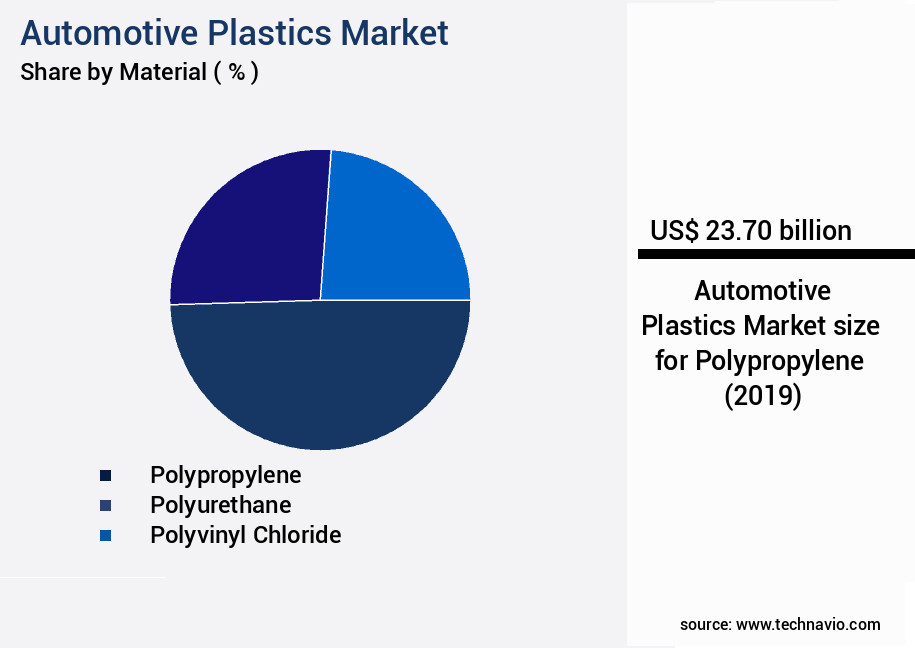
Request Free Sample
The Polypropylene segment was valued at USD 23.70 billion in 2019 and showed a gradual increase during the forecast period.
Sustainable material sourcing and recycled plastic content are increasingly important considerations in the industry. Thermoplastic polyurethanes, thermoplastic elastomers, and acrylonitrile butadiene styrene are other polymers used for various automotive applications. Material flammability standards and UV resistance testing are crucial aspects of the production cycle, ensuring part durability and safety. Finite element analysis and mold flow simulation are essential in tooling design processes to optimize part design and improve production cycle time. Recent advancements include the use of electroplating processes for decorative purposes, enhancing the aesthetics of plastic parts. Color matching techniques and paint adhesion properties are also critical factors in the automotive plastic market.
The industry is continuously focusing on reducing plastic waste through recycling and reusing materials. According to recent statistics, over 50% of all plastic waste is recycled in the automotive industry, demonstrating a strong commitment to sustainability.
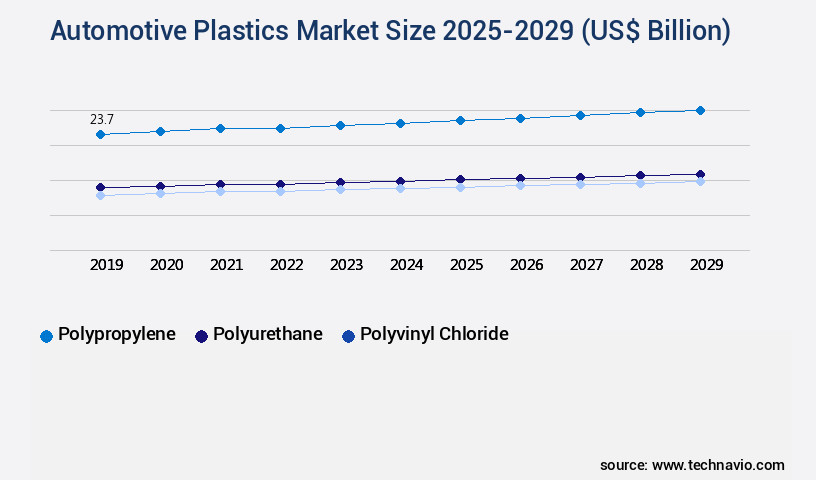
Request Free Sample
Regional Analysis
APAC is estimated to contribute 53% to the growth of the global market during the forecast period. Technavio's analysts have elaborately explained the regional trends and drivers that shape the market during the forecast period.
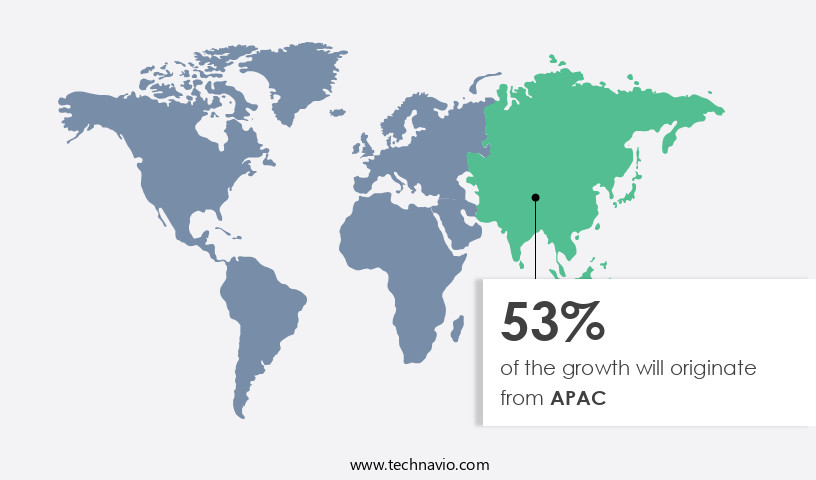
See How Automotive Plastics Market Demand is Rising in APAC Request Free Sample
The market experienced significant growth in recent years, with APAC leading the charge as the largest market shareholder in 2024. Key contributors to this region include China, India, Japan, and South Korea. China, as the largest automotive market in APAC, has seen substantial expansion in automobile production and sales. The Chinese government's initiatives to promote electric vehicles have further fueled the demand for automotive plastics, as they are extensively utilized in electric vehicle components. India's automotive industry is also on the rise, with automotive plastics gaining prominence due to the emphasis on fuel efficiency and lightweighting of vehicles.
Market Dynamics
Our researchers analyzed the data with 2024 as the base year, along with the key drivers, trends, and challenges. A holistic analysis of drivers will help companies refine their marketing strategies to gain a competitive advantage.
The market is experiencing significant growth due to the increasing demand for lightweighting strategies and design innovation in vehicle manufacturing. Injection molding cycle optimization plays a crucial role in reducing production costs and enhancing efficiency in the production of automotive interior trim designs. Recycled plastic automotive parts are gaining popularity as part of sustainable manufacturing initiatives, with polycarbonate blends being a preferred choice for their UV resistance and chemical resistance. Polypropylene, known for its impact strength and tensile strength, is extensively used in the automotive industry for various applications. Flammability testing of plastic parts is essential to ensure safety, while improving paint adhesion on plastics is vital for maintaining the aesthetic appeal of vehicles. UV resistance is a critical factor in the selection of plastics for automotive applications, as exposure to sunlight can degrade the material over time. Finite element analysis and mold flow simulation are essential tools for optimizing the design and manufacturing process of automotive plastic parts. Automotive plastic part assembly techniques, such as electroplating and vacuum forming, are used to enhance the durability and appearance of plastic components. Blow molding and rotational molding are preferred for large parts, while extrusion molding is commonly used for plastic profiles. Design for manufacturing principles are essential in the production of automotive plastics, ensuring that the material selection, design, and manufacturing processes are optimized for cost-effectiveness, efficiency, and quality. The market is expected to continue growing as automakers seek to reduce vehicle weight, improve fuel efficiency, and enhance the overall driving experience.
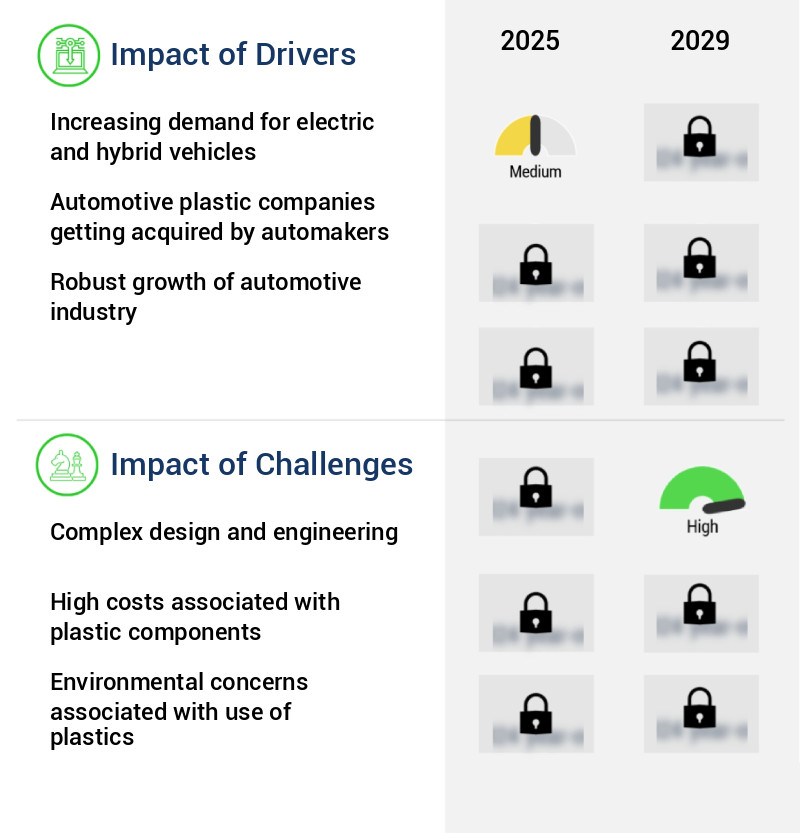
What are the key market drivers leading to the rise in the adoption of Automotive Plastics Industry?
- The surge in demand for electric and hybrid vehicles serves as the primary catalyst for market growth in this sector.
- The automotive industry's evolution has been marked by a significant shift towards electric and hybrid vehicles, driven by environmental concerns and government incentives. These alternatives to traditional internal combustion engine vehicles produce zero emissions, making them a cleaner choice. The demand for lightweight materials in electric and hybrid vehicles is on the rise to offset the weight of batteries and enhance energy efficiency. Automotive plastics have emerged as a popular choice due to their strength, durability, and low weight. According to recent studies, the market is projected to reach a value of around 110 billion USD by 2026, growing at a steady pace.
- Another report suggests that the market share in the global automotive industry is estimated to reach approximately 25% by 2028. This surge in demand for automotive plastics underscores their importance in the evolving automotive landscape.
What are the market trends shaping the Automotive Plastics Industry?
- The market trend indicates a high demand for lightweight and fuel-efficient materials. Two separate yet related trends are emerging in the market: a preference for lightweight materials and a demand for fuel efficiency.
- The automotive industry's evolution centers around the development of lighter vehicles to enhance fuel efficiency and minimize emissions. Automotive plastics have emerged as a significant solution, offering weight reduction while maintaining safety and performance. This shift is driven by increasing consumer awareness and preference for eco-friendly vehicles. For instance, LG Chem's recent innovation, an eco-friendly, flame-retardant PC/ABS plastic, caters to the demanding safety and sustainability standards of the automotive sector and other high-performance industries.
- Advanced plastics and composites are increasingly replacing heavier materials like metal, contributing to a substantial reduction in vehicle weight. This trend aligns with the growing emphasis on reducing carbon emissions and prioritizing fuel efficiency in the automotive market.
What challenges does the Automotive Plastics Industry face during its growth?
- The intricate complexities of design and engineering pose a significant challenge to the expansion of the industry.
- The market is characterized by its evolving nature, with plastic components becoming increasingly essential for modern vehicles due to their lightweight properties and ability to accommodate advanced features. Plastic parts must be meticulously designed and engineered to fit within the vehicle structure and meet functional requirements, necessitating the creation of intricate molds and tooling. Complex geometries, intricate part features, and tight tolerances can add to the complexity of tooling and production setup. Overcoming the challenges of designing and manufacturing complex plastic components requires advanced engineering capabilities and close collaboration between automakers and plastic suppliers.
- The high initial investment and extended lead times associated with tooling for complex plastic components can deter some manufacturers from incorporating plastics into their designs, potentially impacting the expansion of the market.
Exclusive Technavio Analysis on Customer Landscape
The automotive plastics market forecasting report includes the adoption lifecycle of the market, covering from the innovator's stage to the laggard's stage. It focuses on adoption rates in different regions based on penetration. Furthermore, the automotive plastics market report also includes key purchase criteria and drivers of price sensitivity to help companies evaluate and develop their market growth analysis strategies.
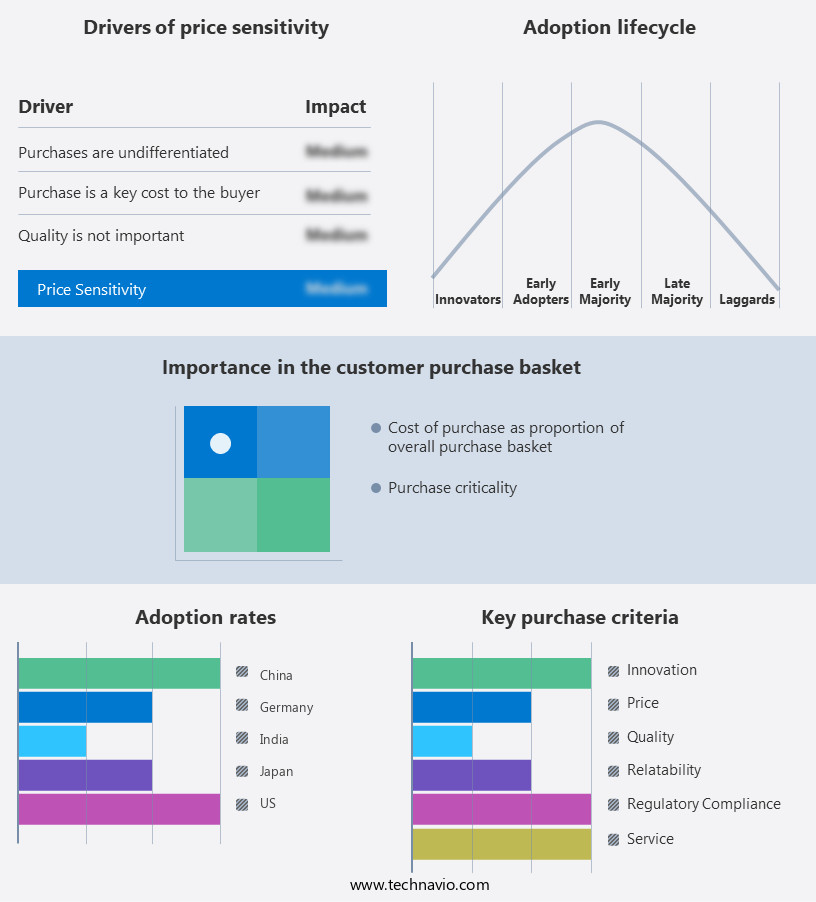
Customer Landscape of Automotive Plastics Industry
Competitive Landscape
Companies are implementing various strategies, such as strategic alliances, automotive plastics market forecast, partnerships, mergers and acquisitions, geographical expansion, and product/service launches, to enhance their presence in the industry.
AGC Inc. - This company specializes in the production and supply of advanced automotive plastics.
The industry research and growth report includes detailed analyses of the competitive landscape of the market and information about key companies, including:
- AGC Inc.
- Avery Dennison Corp.
- BASF SE
- Berghof GmbH
- Borealis AG
- BOS GmbH and Co. KG
- Cascade Engineering
- CIE Automotive SA
- Compagnie de Saint Gobain SA
- Covestro AG
- Eastman Chemical Co.
- Evonik Industries AG
- Nifco Inc.
- Nolato AB
- Novares
- Polystar Technologies LLC.
- W. L. Gore and Associates Inc.
- Weber GmbH and Co. KG
- Yachiyo Industry Co. Ltd.
Qualitative and quantitative analysis of companies has been conducted to help clients understand the wider business environment as well as the strengths and weaknesses of key industry players. Data is qualitatively analyzed to categorize companies as pure play, category-focused, industry-focused, and diversified; it is quantitatively analyzed to categorize companies as dominant, leading, strong, tentative, and weak.
Recent Development and News in Automotive Plastics Market
- In January 2024, BASF, a leading global chemical producer, announced the expansion of its automotive plastic production capacity at its site in Schwarzheide, Germany. This expansion aimed to meet the growing demand for lightweight and sustainable automotive solutions (BASF press release, 2024).
- In March 2024, LG Chem and SK On, two major South Korean battery manufacturers, formed a joint venture to produce automotive batteries and plastic components. This strategic collaboration aimed to combine their expertise in battery technology and plastic manufacturing to offer integrated automotive solutions (Yonhap News Agency, 2024).
- In April 2025, Covestro, a leading polymer manufacturer, launched its new Bayblend NCF series of automotive body components. These components, made from recycled materials, offer improved strength and reduced CO2 emissions, aligning with the industry's shift towards sustainability (Covestro press release, 2025).
- In May 2025, SABIC, a leading petrochemicals manufacturer, received regulatory approval for its new automotive plastic production facility in Saudi Arabia. This USD 1.5 billion project is expected to increase SABIC's automotive plastic production capacity by 50% (Arab News, 2025).
Dive into Technavio's robust research methodology, blending expert interviews, extensive data synthesis, and validated models for unparalleled Automotive Plastics Market insights. See full methodology.
|
Market Scope
|
|
Report Coverage
|
Details
|
|
Page number
|
222
|
|
Base year
|
2024
|
|
Historic period
|
2019-2023 |
|
Forecast period
|
2025-2029
|
|
Growth momentum & CAGR
|
Accelerate at a CAGR of 3.5%
|
|
Market growth 2025-2029
|
USD 15 billion
|
|
Market structure
|
Fragmented
|
|
YoY growth 2024-2025(%)
|
3.3
|
|
Key countries
|
China, US, Japan, India, Germany, South Korea, Canada, UK, Australia, and France
|
|
Competitive landscape
|
Leading Companies, Market Positioning of Companies, Competitive Strategies, and Industry Risks
|
Request Free Sample
Research Analyst Overview
- The market continues to evolve, with ongoing advancements in technologies and applications across various sectors. Electroplating processes are increasingly being used to enhance the surface finish quality of plastic parts, ensuring durability and improved chemical resistance. Injection molding and blow molding processes remain popular for manufacturing automotive interior parts, with a focus on sustainable material sourcing and recycled plastic content. UV resistance testing and chemical resistance testing are crucial for ensuring the longevity of exterior plastic components, such as bumpers and fenders. Polymer compounding and thermoplastic elastomers are essential in producing lightweighting materials, reducing production cycle time and improving part design optimization.
- Material flammability standards are a significant concern in the automotive industry, with finite element analysis and tensile strength analysis used to ensure safety. Acrylonitrile butadiene styrene and polypropylene compounds are commonly used in automotive decoration, while thermoplastic polyurethanes are preferred for their flexibility and impact strength. Automotive plastic recycling is gaining momentum, with a focus on reducing plastic waste and improving sustainability. Rotational molding techniques and vacuum forming processes are used to create complex shapes, while color matching techniques ensure a consistent appearance. According to industry reports, the market is expected to grow by 5% annually over the next decade.
- This growth is driven by the continuous demand for lighter, more durable, and cost-effective materials in the automotive industry. For instance, a leading automaker increased its sales by 10% by using plastic parts in place of traditional metal components.
What are the Key Data Covered in this Automotive Plastics Market Research and Growth Report?
-
What is the expected growth of the Automotive Plastics Market between 2025 and 2029?
-
What segmentation does the market report cover?
-
The report is segmented by Material (Polypropylene, Polyurethane, Polyvinyl chloride, and Others), Vehicle Type (Passenger vehicle, Commercial vehicle, and Electric vehicle), Application (Interior components, Exterior components, Under bonnet, Electrical components, and Others), and Geography (APAC, North America, Europe, South America, and Middle East and Africa)
-
Which regions are analyzed in the report?
-
APAC, North America, Europe, South America, and Middle East and Africa
-
What are the key growth drivers and market challenges?
-
Who are the major players in the Automotive Plastics Market?
-
AGC Inc., Avery Dennison Corp., BASF SE, Berghof GmbH, Borealis AG, BOS GmbH and Co. KG, Cascade Engineering, CIE Automotive SA, Compagnie de Saint Gobain SA, Covestro AG, Eastman Chemical Co., Evonik Industries AG, Nifco Inc., Nolato AB, Novares, Polystar Technologies LLC., W. L. Gore and Associates Inc., Weber GmbH and Co. KG, and Yachiyo Industry Co. Ltd.
Market Research Insights
- The market is a dynamic and ever-evolving industry that continues to organize and innovate. Plastics play a crucial role in automotive manufacturing, with their lightweight properties contributing to fuel efficiency and reduced emissions. According to industry reports, the market is expected to grow by 5% annually over the next decade. One notable example of market growth comes from the adoption of advanced manufacturing processes, such as 3D printing and rapid prototyping methods, which enable faster production cycles and cost reduction strategies. Additionally, the integration of performance simulation software and surface treatment methods facilitates the optimization of manufacturing processes and material selection.
- Moreover, the industry's focus on waste management solutions and plastic degradation studies is essential for addressing environmental concerns and ensuring regulatory compliance with safety standards. With the increasing emphasis on material characterization and property testing, manufacturers can assess creep behavior and fatigue life prediction to improve part lifecycle management and design verification testing. Furthermore, the implementation of additive manufacturing techniques and design for recyclability is a significant trend in the market, as it supports the reduction of emissions and the circular economy. These advancements, along with the continuous development of polymer modification techniques and supply chain management strategies, contribute to the industry's ongoing evolution.
We can help! Our analysts can customize this automotive plastics market research report to meet your requirements.
Get in touch
1 Executive Summary
- 1.1 Market overview
- Executive Summary - Chart on Market Overview
- Executive Summary - Data Table on Market Overview
- Executive Summary - Chart on Global Market Characteristics
- Executive Summary - Chart on Market by Geography
- Executive Summary - Chart on Market Segmentation by Material
- Executive Summary - Chart on Market Segmentation by Vehicle Type
- Executive Summary - Chart on Market Segmentation by Application
- Executive Summary - Chart on Incremental Growth
- Executive Summary - Data Table on Incremental Growth
- Executive Summary - Chart on Company Market Positioning
2 Technavio Analysis
- 2.1 Analysis of price sensitivity, lifecycle, customer purchase basket, adoption rates, and purchase criteria
- Analysis of price sensitivity, lifecycle, customer purchase basket, adoption rates, and purchase criteria
- 2.2 Criticality of inputs and Factors of differentiation
- Overview on criticality of inputs and factors of differentiation
- 2.3 Factors of disruption
- Overview on factors of disruption
- 2.4 Impact of drivers and challenges
- Impact of drivers and challenges in 2024 and 2029
3 Market Landscape
- 3.1 Market ecosystem
- Parent Market
- Data Table on - Parent Market
- 3.2 Market characteristics
- Market characteristics analysis
4 Market Sizing
- 4.1 Market definition
- Offerings of companies included in the market definition
- 4.2 Market segment analysis
- 4.4 Market outlook: Forecast for 2024-2029
- Chart on Global - Market size and forecast 2024-2029 ($ billion)
- Data Table on Global - Market size and forecast 2024-2029 ($ billion)
- Chart on Global Market: Year-over-year growth 2024-2029 (%)
- Data Table on Global Market: Year-over-year growth 2024-2029 (%)
5 Historic Market Size
- 5.1 Global Automotive Plastics Market 2019 - 2023
- Historic Market Size - Data Table on Global Automotive Plastics Market 2019 - 2023 ($ billion)
- 5.2 Material segment analysis 2019 - 2023
- Historic Market Size - Material Segment 2019 - 2023 ($ billion)
- 5.3 Vehicle Type segment analysis 2019 - 2023
- Historic Market Size - Vehicle Type Segment 2019 - 2023 ($ billion)
- 5.4 Application segment analysis 2019 - 2023
- Historic Market Size - Application Segment 2019 - 2023 ($ billion)
- 5.5 Geography segment analysis 2019 - 2023
- Historic Market Size - Geography Segment 2019 - 2023 ($ billion)
- 5.6 Country segment analysis 2019 - 2023
- Historic Market Size - Country Segment 2019 - 2023 ($ billion)
6 Qualitative Analysis
- 6.1 The impact of AI in the global automotive plastics market
7 Five Forces Analysis
- 7.1 Five forces summary
- Five forces analysis - Comparison between 2024 and 2029
- 7.2 Bargaining power of buyers
- Bargaining power of buyers - Impact of key factors 2024 and 2029
- 7.3 Bargaining power of suppliers
- Bargaining power of suppliers - Impact of key factors in 2024 and 2029
- 7.4 Threat of new entrants
- Threat of new entrants - Impact of key factors in 2024 and 2029
- 7.5 Threat of substitutes
- Threat of substitutes - Impact of key factors in 2024 and 2029
- 7.6 Threat of rivalry
- Threat of rivalry - Impact of key factors in 2024 and 2029
- 7.7 Market condition
- Chart on Market condition - Five forces 2024 and 2029
8 Market Segmentation by Material
- 8.1 Market segments
- Chart on Material - Market share 2024-2029 (%)
- Data Table on Material - Market share 2024-2029 (%)
- 8.2 Comparison by Material
- Chart on Comparison by Material
- Data Table on Comparison by Material
- 8.3 Polypropylene - Market size and forecast 2024-2029
- Chart on Polypropylene - Market size and forecast 2024-2029 ($ billion)
- Data Table on Polypropylene - Market size and forecast 2024-2029 ($ billion)
- Chart on Polypropylene - Year-over-year growth 2024-2029 (%)
- Data Table on Polypropylene - Year-over-year growth 2024-2029 (%)
- 8.4 Polyurethane - Market size and forecast 2024-2029
- Chart on Polyurethane - Market size and forecast 2024-2029 ($ billion)
- Data Table on Polyurethane - Market size and forecast 2024-2029 ($ billion)
- Chart on Polyurethane - Year-over-year growth 2024-2029 (%)
- Data Table on Polyurethane - Year-over-year growth 2024-2029 (%)
- 8.5 Polyvinyl chloride - Market size and forecast 2024-2029
- Chart on Polyvinyl chloride - Market size and forecast 2024-2029 ($ billion)
- Data Table on Polyvinyl chloride - Market size and forecast 2024-2029 ($ billion)
- Chart on Polyvinyl chloride - Year-over-year growth 2024-2029 (%)
- Data Table on Polyvinyl chloride - Year-over-year growth 2024-2029 (%)
- 8.6 Others - Market size and forecast 2024-2029
- Chart on Others - Market size and forecast 2024-2029 ($ billion)
- Data Table on Others - Market size and forecast 2024-2029 ($ billion)
- Chart on Others - Year-over-year growth 2024-2029 (%)
- Data Table on Others - Year-over-year growth 2024-2029 (%)
- 8.7 Market opportunity by Material
- Market opportunity by Material ($ billion)
- Data Table on Market opportunity by Material ($ billion)
9 Market Segmentation by Vehicle Type
- 9.1 Market segments
- Chart on Vehicle Type - Market share 2024-2029 (%)
- Data Table on Vehicle Type - Market share 2024-2029 (%)
- 9.2 Comparison by Vehicle Type
- Chart on Comparison by Vehicle Type
- Data Table on Comparison by Vehicle Type
- 9.3 Passenger vehicle - Market size and forecast 2024-2029
- Chart on Passenger vehicle - Market size and forecast 2024-2029 ($ billion)
- Data Table on Passenger vehicle - Market size and forecast 2024-2029 ($ billion)
- Chart on Passenger vehicle - Year-over-year growth 2024-2029 (%)
- Data Table on Passenger vehicle - Year-over-year growth 2024-2029 (%)
- 9.4 Commercial vehicle - Market size and forecast 2024-2029
- Chart on Commercial vehicle - Market size and forecast 2024-2029 ($ billion)
- Data Table on Commercial vehicle - Market size and forecast 2024-2029 ($ billion)
- Chart on Commercial vehicle - Year-over-year growth 2024-2029 (%)
- Data Table on Commercial vehicle - Year-over-year growth 2024-2029 (%)
- 9.5 Electric vehicle - Market size and forecast 2024-2029
- Chart on Electric vehicle - Market size and forecast 2024-2029 ($ billion)
- Data Table on Electric vehicle - Market size and forecast 2024-2029 ($ billion)
- Chart on Electric vehicle - Year-over-year growth 2024-2029 (%)
- Data Table on Electric vehicle - Year-over-year growth 2024-2029 (%)
- 9.6 Market opportunity by Vehicle Type
- Market opportunity by Vehicle Type ($ billion)
- Data Table on Market opportunity by Vehicle Type ($ billion)
10 Market Segmentation by Application
- 10.1 Market segments
- Chart on Application - Market share 2024-2029 (%)
- Data Table on Application - Market share 2024-2029 (%)
- 10.2 Comparison by Application
- Chart on Comparison by Application
- Data Table on Comparison by Application
- 10.3 Interior components - Market size and forecast 2024-2029
- Chart on Interior components - Market size and forecast 2024-2029 ($ billion)
- Data Table on Interior components - Market size and forecast 2024-2029 ($ billion)
- Chart on Interior components - Year-over-year growth 2024-2029 (%)
- Data Table on Interior components - Year-over-year growth 2024-2029 (%)
- 10.4 Exterior components - Market size and forecast 2024-2029
- Chart on Exterior components - Market size and forecast 2024-2029 ($ billion)
- Data Table on Exterior components - Market size and forecast 2024-2029 ($ billion)
- Chart on Exterior components - Year-over-year growth 2024-2029 (%)
- Data Table on Exterior components - Year-over-year growth 2024-2029 (%)
- 10.5 Under bonnet - Market size and forecast 2024-2029
- Chart on Under bonnet - Market size and forecast 2024-2029 ($ billion)
- Data Table on Under bonnet - Market size and forecast 2024-2029 ($ billion)
- Chart on Under bonnet - Year-over-year growth 2024-2029 (%)
- Data Table on Under bonnet - Year-over-year growth 2024-2029 (%)
- 10.6 Electrical components - Market size and forecast 2024-2029
- Chart on Electrical components - Market size and forecast 2024-2029 ($ billion)
- Data Table on Electrical components - Market size and forecast 2024-2029 ($ billion)
- Chart on Electrical components - Year-over-year growth 2024-2029 (%)
- Data Table on Electrical components - Year-over-year growth 2024-2029 (%)
- 10.7 Others - Market size and forecast 2024-2029
- Chart on Others - Market size and forecast 2024-2029 ($ billion)
- Data Table on Others - Market size and forecast 2024-2029 ($ billion)
- Chart on Others - Year-over-year growth 2024-2029 (%)
- Data Table on Others - Year-over-year growth 2024-2029 (%)
- 10.8 Market opportunity by Application
- Market opportunity by Application ($ billion)
- Data Table on Market opportunity by Application ($ billion)
11 Customer Landscape
- 11.1 Customer landscape overview
- Analysis of price sensitivity, lifecycle, customer purchase basket, adoption rates, and purchase criteria
12 Geographic Landscape
- 12.1 Geographic segmentation
- Chart on Market share by geography 2024-2029 (%)
- Data Table on Market share by geography 2024-2029 (%)
- 12.2 Geographic comparison
- Chart on Geographic comparison
- Data Table on Geographic comparison
- 12.3 APAC - Market size and forecast 2024-2029
- Chart on APAC - Market size and forecast 2024-2029 ($ billion)
- Data Table on APAC - Market size and forecast 2024-2029 ($ billion)
- Chart on APAC - Year-over-year growth 2024-2029 (%)
- Data Table on APAC - Year-over-year growth 2024-2029 (%)
- 12.4 North America - Market size and forecast 2024-2029
- Chart on North America - Market size and forecast 2024-2029 ($ billion)
- Data Table on North America - Market size and forecast 2024-2029 ($ billion)
- Chart on North America - Year-over-year growth 2024-2029 (%)
- Data Table on North America - Year-over-year growth 2024-2029 (%)
- 12.5 Europe - Market size and forecast 2024-2029
- Chart on Europe - Market size and forecast 2024-2029 ($ billion)
- Data Table on Europe - Market size and forecast 2024-2029 ($ billion)
- Chart on Europe - Year-over-year growth 2024-2029 (%)
- Data Table on Europe - Year-over-year growth 2024-2029 (%)
- 12.6 South America - Market size and forecast 2024-2029
- Chart on South America - Market size and forecast 2024-2029 ($ billion)
- Data Table on South America - Market size and forecast 2024-2029 ($ billion)
- Chart on South America - Year-over-year growth 2024-2029 (%)
- Data Table on South America - Year-over-year growth 2024-2029 (%)
- 12.7 Middle East and Africa - Market size and forecast 2024-2029
- Chart on Middle East and Africa - Market size and forecast 2024-2029 ($ billion)
- Data Table on Middle East and Africa - Market size and forecast 2024-2029 ($ billion)
- Chart on Middle East and Africa - Year-over-year growth 2024-2029 (%)
- Data Table on Middle East and Africa - Year-over-year growth 2024-2029 (%)
- 12.8 China - Market size and forecast 2024-2029
- Chart on China - Market size and forecast 2024-2029 ($ billion)
- Data Table on China - Market size and forecast 2024-2029 ($ billion)
- Chart on China - Year-over-year growth 2024-2029 (%)
- Data Table on China - Year-over-year growth 2024-2029 (%)
- 12.9 US - Market size and forecast 2024-2029
- Chart on US - Market size and forecast 2024-2029 ($ billion)
- Data Table on US - Market size and forecast 2024-2029 ($ billion)
- Chart on US - Year-over-year growth 2024-2029 (%)
- Data Table on US - Year-over-year growth 2024-2029 (%)
- 12.10 Japan - Market size and forecast 2024-2029
- Chart on Japan - Market size and forecast 2024-2029 ($ billion)
- Data Table on Japan - Market size and forecast 2024-2029 ($ billion)
- Chart on Japan - Year-over-year growth 2024-2029 (%)
- Data Table on Japan - Year-over-year growth 2024-2029 (%)
- 12.11 India - Market size and forecast 2024-2029
- Chart on India - Market size and forecast 2024-2029 ($ billion)
- Data Table on India - Market size and forecast 2024-2029 ($ billion)
- Chart on India - Year-over-year growth 2024-2029 (%)
- Data Table on India - Year-over-year growth 2024-2029 (%)
- 12.12 Germany - Market size and forecast 2024-2029
- Chart on Germany - Market size and forecast 2024-2029 ($ billion)
- Data Table on Germany - Market size and forecast 2024-2029 ($ billion)
- Chart on Germany - Year-over-year growth 2024-2029 (%)
- Data Table on Germany - Year-over-year growth 2024-2029 (%)
- 12.13 South Korea - Market size and forecast 2024-2029
- Chart on South Korea - Market size and forecast 2024-2029 ($ billion)
- Data Table on South Korea - Market size and forecast 2024-2029 ($ billion)
- Chart on South Korea - Year-over-year growth 2024-2029 (%)
- Data Table on South Korea - Year-over-year growth 2024-2029 (%)
- 12.14 Canada - Market size and forecast 2024-2029
- Chart on Canada - Market size and forecast 2024-2029 ($ billion)
- Data Table on Canada - Market size and forecast 2024-2029 ($ billion)
- Chart on Canada - Year-over-year growth 2024-2029 (%)
- Data Table on Canada - Year-over-year growth 2024-2029 (%)
- 12.15 UK - Market size and forecast 2024-2029
- Chart on UK - Market size and forecast 2024-2029 ($ billion)
- Data Table on UK - Market size and forecast 2024-2029 ($ billion)
- Chart on UK - Year-over-year growth 2024-2029 (%)
- Data Table on UK - Year-over-year growth 2024-2029 (%)
- 12.16 Australia - Market size and forecast 2024-2029
- Chart on Australia - Market size and forecast 2024-2029 ($ billion)
- Data Table on Australia - Market size and forecast 2024-2029 ($ billion)
- Chart on Australia - Year-over-year growth 2024-2029 (%)
- Data Table on Australia - Year-over-year growth 2024-2029 (%)
- 12.17 France - Market size and forecast 2024-2029
- Chart on France - Market size and forecast 2024-2029 ($ billion)
- Data Table on France - Market size and forecast 2024-2029 ($ billion)
- Chart on France - Year-over-year growth 2024-2029 (%)
- Data Table on France - Year-over-year growth 2024-2029 (%)
- 12.18 Market opportunity by geography
- Market opportunity by geography ($ billion)
- Data Tables on Market opportunity by geography ($ billion)
13 Drivers, Challenges, and Opportunity/Restraints
- 13.3 Impact of drivers and challenges
- Impact of drivers and challenges in 2024 and 2029
- 13.4 Market opportunities/restraints
14 Competitive Landscape
- 14.2 Competitive Landscape
- Overview on criticality of inputs and factors of differentiation
- 14.3 Landscape disruption
- Overview on factors of disruption
- 14.4 Industry risks
- Impact of key risks on business
15 Competitive Analysis
- 15.2 Company ranking index
- 15.3 Market positioning of companies
- Matrix on companies position and classification
- 15.4 AGC Inc.
- AGC Inc. - Overview
- AGC Inc. - Business segments
- AGC Inc. - Key news
- AGC Inc. - Key offerings
- AGC Inc. - Segment focus
- SWOT
- 15.5 Avery Dennison Corp.
- Avery Dennison Corp. - Overview
- Avery Dennison Corp. - Business segments
- Avery Dennison Corp. - Key news
- Avery Dennison Corp. - Key offerings
- Avery Dennison Corp. - Segment focus
- SWOT
- 15.6 BASF SE
- BASF SE - Overview
- BASF SE - Business segments
- BASF SE - Key news
- BASF SE - Key offerings
- BASF SE - Segment focus
- SWOT
- 15.7 Berghof GmbH
- Berghof GmbH - Overview
- Berghof GmbH - Product / Service
- Berghof GmbH - Key offerings
- SWOT
- 15.8 Borealis AG
- Borealis AG - Overview
- Borealis AG - Business segments
- Borealis AG - Key offerings
- Borealis AG - Segment focus
- SWOT
- 15.9 BOS GmbH and Co. KG
- BOS GmbH and Co. KG - Overview
- BOS GmbH and Co. KG - Product / Service
- BOS GmbH and Co. KG - Key offerings
- SWOT
- 15.10 CIE Automotive SA
- CIE Automotive SA - Overview
- CIE Automotive SA - Business segments
- CIE Automotive SA - Key news
- CIE Automotive SA - Key offerings
- CIE Automotive SA - Segment focus
- SWOT
- 15.11 Compagnie de Saint Gobain SA
- Compagnie de Saint Gobain SA - Overview
- Compagnie de Saint Gobain SA - Business segments
- Compagnie de Saint Gobain SA - Key news
- Compagnie de Saint Gobain SA - Key offerings
- Compagnie de Saint Gobain SA - Segment focus
- SWOT
- 15.12 Covestro AG
- Covestro AG - Overview
- Covestro AG - Business segments
- Covestro AG - Key news
- Covestro AG - Key offerings
- Covestro AG - Segment focus
- SWOT
- 15.13 Eastman Chemical Co.
- Eastman Chemical Co. - Overview
- Eastman Chemical Co. - Business segments
- Eastman Chemical Co. - Key news
- Eastman Chemical Co. - Key offerings
- Eastman Chemical Co. - Segment focus
- SWOT
- 15.14 Evonik Industries AG
- Evonik Industries AG - Overview
- Evonik Industries AG - Business segments
- Evonik Industries AG - Key news
- Evonik Industries AG - Key offerings
- Evonik Industries AG - Segment focus
- SWOT
- 15.15 Nifco Inc.
- Nifco Inc. - Overview
- Nifco Inc. - Business segments
- Nifco Inc. - Key offerings
- Nifco Inc. - Segment focus
- SWOT
- 15.16 Nolato AB
- Nolato AB - Overview
- Nolato AB - Product / Service
- Nolato AB - Key offerings
- SWOT
- 15.17 Weber GmbH and Co. KG
- Weber GmbH and Co. KG - Overview
- Weber GmbH and Co. KG - Product / Service
- Weber GmbH and Co. KG - Key offerings
- SWOT
- 15.18 Yachiyo Industry Co. Ltd.
- Yachiyo Industry Co. Ltd. - Overview
- Yachiyo Industry Co. Ltd. - Product / Service
- Yachiyo Industry Co. Ltd. - Key offerings
- SWOT
16 Appendix
- 16.2 Inclusions and exclusions checklist
- Inclusions checklist
- Exclusions checklist
- 16.3 Currency conversion rates for US$
- Currency conversion rates for US$
- 16.4 Research methodology
- 16.7 Validation techniques employed for market sizing
- Validation techniques employed for market sizing
- 16.9 360 degree market analysis
- 360 degree market analysis
- 16.10 List of abbreviations







![]() Get the report (PDF) sent to your email within minutes.
Get the report (PDF) sent to your email within minutes.
Complimentary full Excel data with your report purchase.